挪威石油标准化组织规范-介绍
NORSOK 标准简介[最新]
![NORSOK 标准简介[最新]](https://img.taocdn.com/s3/m/a4c061b0b7360b4c2e3f64e0.png)
NORSOK 标准简介[最新]NORSOK 标准简介挪威石油工业技术法规挪威现为西欧最大产油国、世界第三大石油出口国,近海石油工业已成为国民经济重要支柱。
2001年原油产量1.98亿t,开采天然气532.0亿m3,油、气总产量为2.51亿t油当量;总产值3185.0亿克朗,占国民生产总值的22.6,;油气出口额为3069亿克朗,占挪威总出口额的45.1,。
挪威在石油业取得的成就,除了有丰富资源外,与技术的进步及在法规、标准约束下的规范工作分不开。
挪威的石油技术法规与标准工作是于20世纪60年代开始,70年代达到高峰,过去制定的是详细与说明性的法规与指南,及许多私有石油公司的规范,但人们逐渐发现挪威的技术法规已不够适用,所以开始制定新的法规。
1993年挪威石油工业成立了挪威石油标准化组织(NORSOK),力图通过发展标准的方法来协调、减少石油公司规范的数量。
NORSOK主动从技术法规中吸取相关技术细节、服从行业评定、符合法规要求、制定功能规范,2000年制定完成了一批相关方一致同意的技术标准,为新技术法规的制定奠定了基础。
挪威不是欧盟成员国,但在制定新技术法规方面仍遵循欧盟的方针,倾向于建立只有基本要求的技术法规,而细节则由标准提出。
挪威的法规分为4个层次:第一层次为框架法规,是由议会通过的皇家法令,涉及的范围比较广泛。
第二层次为法规,由立法机构制定,其中不包括对标准的引用,如果有背离,须向立法机构提出申请。
第三层次为指南,由立法机构制定,包括对标准的引用。
如果有背离,由公司自行管理并形成文件。
第四层次为阐释,即对各种法规与指南细节的解释。
2001年8月31日皇家议会通过了5个石油工业技术法规,2001年9月3日由挪威石油安全机构(PSA)、?挪威污)联合颁布、实施了这5个新染控制机构(SFT)、挪威社会健康理事会(NSHD 的法规(表1)。
这5个新法规实际是整合、替代了原有的25个不适用的旧法规。
挪威船级社标准(压力容器篇)
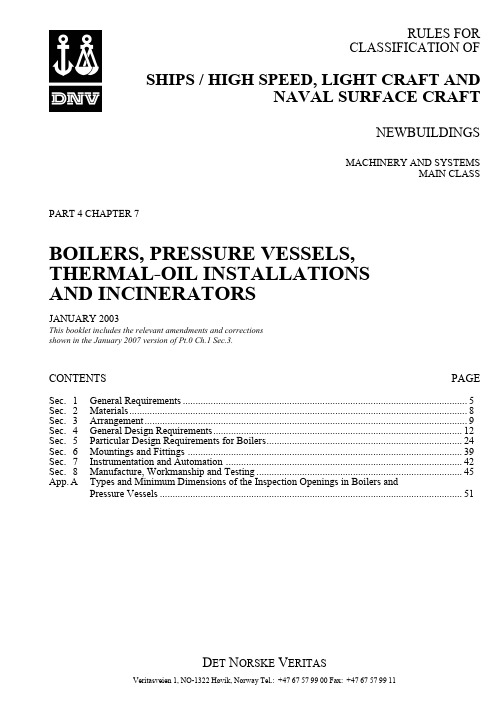
RULES FORCLASSIFICATION OFD ET N ORSKE V ERITASVeritasveien 1, NO-1322 Høvik, Norway Tel.: +47 67 57 99 00 Fax: +47 67 57 99 11SHIPS / HIGH SPEED, LIGHT CRAFT ANDNAVAL SURFACE CRAFTNEWBUILDINGSMACHINERY AND SYSTEMSMAIN CLASSPART 4 CHAPTER 7BOILERS, PRESSURE VESSELS, THERMAL-OIL INSTALLATIONS AND INCINERATORSJANUARY 2003This booklet includes the relevant amendments and corrections shown in the January 2007 version of Pt.0 Ch.1 Sec.3.CONTENTSPAGESec.1General Requirements................................................................................................................5Sec.2Materials.....................................................................................................................................8Sec.3Arrangement...............................................................................................................................9Sec.4General Design Requirements..................................................................................................12Sec.5Particular Design Requirements for Boilers.............................................................................24Sec.6Mountings and Fittings ............................................................................................................39Sec.7Instrumentation and Automation .............................................................................................42Sec.8Manufacture, Workmanship and Testing.................................................................................45App.ATypes and Minimum Dimensions of the Inspection Openings in Boilers andPressure Vessels (51)CHANGES IN THE RULESComments to the rules may be sent by e-mail to rules@For subscription orders or information about subscription terms, please use distribution@Comprehensive information about DNV and the Society's services is found at the Web site © Det Norske VeritasComputer Typesetting (FM+SGML) by Det Norske Veritas Printed in NorwayIf any person suffers loss or damage which is proved to have been caused by any negligent act or omission of Det Norske Veritas, then Det Norske Veritas shall pay compensation to such person for his proved direct loss or damage. However, the compensation shall not exceed an amount equal to ten times the fee charged for the service in question, provided that the maximum compen-sation shall never exceed USD 2 million.In this provision "Det Norske Veritas" shall mean the Foundation Det Norske Veritas as well as all its subsidiaries, directors, officers, employees, agents and any other acting on behalf of Det Norske Veritas.GeneralThis booklet is a reprint of the previous edition and apart from clari-fications of text and the inclusion of amendments and corrections,published in the July 2002 edition of Pt.0 Ch.1 Sec.3, no other chang-es have been made.This chapter is valid until superseded by a revised chapter. Supple-ments will not be issued except for an updated list of minor amend-ments and corrections presented in Pt.0 Ch.1 Sec.3. Pt.0 Ch.1 is normally revised in January and July each year.Revised chapters will be forwarded to all subscribers to the rules.Buyers of reprints are advised to check the updated list of rule chap-ters printed in Pt.0 Ch.1 Sec.1 to ensure that the chapter is current.Amended,Rules for Ships / High Speed, Light Craft and Naval Surface Craft, January 2003see Pt.0 Ch.1 Sec.3, January 2007 Pt.4 Ch.7 Contents – Page 3D ET N ORSKE V ERITASCONTENTSSEC. 1GENERAL REQUIREMENTS.......................... 5A.Classification.. (5)A 100Application........................................................................5A 200Cross-references. (5)B.Definitions (5)B 100Terms................................................................................5B 200Symbols.............................................................................5B 300Units..................................................................................5B 400Grading (5)C.Documentation (6)C 100General..............................................................................6C 200Boilers and pressure vessels..............................................6C 300Thermal-oil installations...................................................6C 400Incinerators (7)D.Seamless Gas Cylinders (7)D 100Certification......................................................................7E.Signboards.. (7)E 100General (7)SEC. 2MATERIALS........................................................ 8A.Material Requirements (8)A 100General..............................................................................8A 200Boilers and pressure vessels..............................................8A 300Valves and fittings............................................................8A 400Thermal-oil installations (8)SEC. 3ARRANGEMENT................................................ 9A.Boilers and Pressure Vessels .. (9)A 100Instruments........................................................................9A 200Inspection openings ..........................................................9A 300Drains................................................................................9A 400Fuel oil supply...................................................................9A 500Combustion air supply......................................................9A 600Positioning (9)B.Thermal-oil Installations (9)B 100Installation.........................................................................9B 200Circulation system ............................................................9B 300Control and monitoring system.......................................10B 400Safety arrangements........................................................10B 500Insulation and shielding..................................................10B 600Exhaust-fired thermal-oil heaters....................................10B 700Test equipment and signboards.......................................10C.Incinerators.. (10)C 100General............................................................................10D.Exhaust Gas Boiler or Economisers. (11)D 100Circulation systems.........................................................11D 200Soot-cleaning arrangement (11)SEC. 4GENERAL DESIGN REQUIREMENTS........ 12A.General (12)A 100Application (12)B.Design Criteria (12)B 100Design pressure...............................................................12B 200Calculating pressure........................................................12B 300Other loadings.................................................................12B 400Design material temperature...........................................12B 500Nominal design stress.....................................................13B 600Shell thickness ................................................................13B 700Corrosion allowance.......................................................13B800Tolerance and fabrication allowance (13)C.Scantlings of Shells and Flat and Dished Ends (14)C 100Conditions.......................................................................14C 200Cylindrical shells ............................................................14C 300Spherical shells (14)C 400Conical shells of circular sections...................................14C 500Dished ends.....................................................................15C 600Unstayed flat end plates..................................................17D.Openings and Compensations. (18)D 100General............................................................................18D 200Openings not requiring reinforcement............................18D 300Openings requiring reinforcement..................................18D 400Minimum thickness of standpipes and branches............19D 500Welded branch connections............................................19E.Covers for Inspection Openings and Manholes .. (22)E 100General (22)F.Heat Exchanger Tubes (22)F 100General (22)SEC. 5PARTICULAR DESIGN REQUIREMENTSFOR BOILERS................................................... 24A.Shells and Headers of Cylindrical Sections (24)A 100Scantlings........................................................................24A 200Efficiency of ligaments between tube holes...................24A 300Compensating effect of tube stubs..................................26B.Headers of Rectangular or Irregular Sections. (28)B 100Headers of rectangular section........................................28B 200Headers of irregular form................................................29C.Dished Ends (29)C 100Dished ends subject to pressure on the concave side......29C 200Dished ends subject to pressure on the convex side. (29)D.Flat Plates Supported by Stays (29)D 100General............................................................................29D 200Scantlings........................................................................30D 300Stay tubes and tube plates within tube nests ..................30D 400Vertical tube plates in vertical boilers............................31D 500Firebox plates under compression..................................33D 600Openings in flat plates (33)E.Furnaces and Fireboxes of Cylindrical Form, Uptakes, Cross-tubes and Ogee Rings (35)E 100Plain furnaces .................................................................35E 200Corrugated furnaces........................................................35E 300Stiffeners.........................................................................36E 400Fireboxes for vertical boilers..........................................36E 500Openings in furnaces.......................................................36E 600Dished ends for vertical boiler fireboxes........................36E 700Internal uptakes in vertical boilers..................................36E 800Cross-tubes in vertical boilers.........................................37E 900Connection of firebox to shell in vertical boilers............37F.Stays. (37)F 100Stay tubes and bar stays .................................................37F 200Girders for flat firebox and reversal chambers'top plates.........................................................................37G.Tubes.. (37)G 100Boiler tubes subjected to internal pressure.....................37G 200Boiler tubes subjected to external pressure (38)H.Access and Inspection Openings (38)H 100General (38)SEC. 6MOUNTINGS AND FITTINGS ...................... 39A.General.. (39)A 100Construction (39)B.Safety Valves (39)B 100Valves on boilers and steam-heated steam generators....39B 200Valves on pressure vessels other than boilers and steam-heated steam generators..................................................40B 300Protection of condensers against overpressure (40)Rules for Ships / High Speed, Light Craft and Naval Surface Craft, January 2003Amended,Pt.4 Ch.7 Contents – Page 4 see Pt.0 Ch.1 Sec.3, January 2007D ET N ORSKE V ERITASC.Stop Valves and Check Valves (40)C 100Valves on boilers and steam-heated steam generators....40C 200Valves on pressure vessels other than boilers and steam-heated steam generators (40)D.Blow-down Valves and Test Valves for Boiler Water (41)D 100Blow-down valves...........................................................41D 200Test valves.......................................................................41E.Gauges. (41)E 100Water gauges...................................................................41E 200Pressure gauges (41)SEC. 7INSTRUMENTATION ANDAUTOMATION ................................................. 42A.General.. (42)A 100Cross reference................................................................42A 200Oil burner control system (42)B.Boilers (42)B 100Automatic control ...........................................................42B 200Monitoring......................................................................42C.Exhaust Gas Boilers or Economisers.. (42)C 100Instruments and Monitoring (42)D.Water Heaters (42)D 100Monitoring (42)E.Thermal-oil Heaters (43)E 100Automatic control ...........................................................43E 200Monitoring......................................................................43E 300Indication ........................................................................43F.Incinerators. (43)F 100Monitoring (43)SEC. 8MANUFACTURE, WORKMANSHIP ANDTESTING............................................................ 45A.Manufacture (45)A 100General............................................................................45B.Workmanship. (45)B 100Cutting of plates..............................................................45B 200Welded joints..................................................................45B 300Tolerances for shells.......................................................45B 400Fitting of tubes................................................................46B500Doors and plugs (46)C.Heat Treatment (46)C 100Post-weld heat treatment.................................................46C 200Heat treatment of plates after hot or cold forming..........46C 300Heat treatment of tubes after bending (47)D.Testing (47)D 100Extent of non-destructive testing (NDT)........................47D 200Performance of non-destructive testing (NDT)..............47D 300Acceptance criteria for non-destructive testing and repair of defects.........................................................................48D 400Welding production test (WPT)......................................49D 500Hydraulic test..................................................................50D 600Performance test..............................................................50E.Marking. (50)E 100General (50)APP. A TYPES AND MINIMUM DIMENSIONS OF THE INSPECTION OPENINGS IN BOILERS ANDPRESSURE VESSELS ..................................................... 51A.Definitions and Dimensions.. (51)A 100Examination holes...........................................................51A 200Man-holes (51)Amended,Rules for Ships / High Speed, Light Craft and Naval Surface Craft, January 2003see Pt.0 Ch.1 Sec.3, January 2007 Pt.4 Ch.7 Sec.1 – Page 5D ET N ORSKE V ERITASSECTION 1GENERAL REQUIREMENTSA. ClassificationA 100Application101 The rules in this chapter apply to:—boilers, including mountings—pressure vessels, including mountings, necessary for per-forming the main functions listed in Pt.1 Ch.1 Sec.2 of the Rules for Classification of Ships —other pressure vessels containing:—toxic fluids—fluids with flash point below 100°C —fluids with temperature above 220°C —fluids with pressure above 40 bar —compressed gases where pV ≥ 1.5p =design pressure in bar V =volume in m 3—thermal-oil installations—permanently installed incinerators.102 Boilers and pressure vessels according to 101 are subject to certification by the Society.103 The control and monitoring systems shall be certified according to Ch.9 for the following:—boilers—thermal-oil installations —incinerators—oil fired water heaters.A 200Cross-references201 Pressure vessels for liquefied gases are to meet the re-quirements in the Rules for Classification of Ships Pt.5 Ch.5Sec.5.Cargo process pressure vessels, as defined in the Rules for Classification of Ships Pt.5 Ch.5 Sec.1, are to be graded as class I pressure vessels. However, the selections of materials,qualification of welding procedures and production weld tests are to be according to the Rules for Classification of Ships Pt.5Ch.5 Sec.2 and Sec.5. Non-cargo process pressure vessels, as defined in the Rules for Classification of Ships Pt.5 Ch.5Sec.1, are to meet the requirements of Ch.7.Boiler installations on liquefied gas carriers with gas operated machinery are to meet the requirements in the Rules for Clas-sification of Ships Pt.5 Ch.5 Sec.16.202 Pressure vessels for refrigerating plants are, in addition to the requirements in this chapter, to meet the requirements of the Rules for Classification of Ships Pt.5 Ch.10.B. DefinitionsB 100Terms101 A boiler is defined as a welded container or a pipe ar-rangement in which steam or hot water with a temperature ex-ceeding 120°C is generated by the application of heat,resulting from the combusting of fuel (solid, liquid or gaseous)or from hot combustion gases.Superheaters, economisers, reheaters and other pressure parts including valves and fittings, connected directly to the boiler without intervening valves, are to be considered as parts of the boiler.102 A thermal-oil installation is defined as an arrangement in which thermal-oil is heated and circulated for the purpose of heating cargo- or fuel oil or for production of steam and hot water for auxiliary purposes.103 An incinerator is defined as a permanently installed ar-rangement for the purpose of burning products such as sludgeoil with flash point above 60°C and other waste products which do not cause danger of explosion.B 200Symbols201 The symbols used are as given below in addition to those specifically stated in the relevant sections.p =calculating pressure, in bar D =nominal diameter, in mm T =design temperature, in °Cc =corrosion margin, see Sec.4 B700σt=nominal design stress at design metal tempera-ture, in N/mm 2R m =specified minimum tensile strength at room tem-perature, in N/mm 2R mt =specified minimum tensile strength at designmaterial temperature in N/mm 2R eH =specified minimum upper yield stress at roomtemperature, in N/mm 2. If the stress-strain curve does not show a defined yield stress, the 0.2%proof stress is to be appliedR et =specified minimum lower yield stress at designmaterial temperature in N/mm 2. If the stress-strain curve does not show a defined yield stress,the 0.2% proof stress is to be appliedR m/100000 =average stress to produce rupture in 100 000hours at design material temperature in N/mm 2R p1.0 = 1.0% proof stress in N/mm 2.B 300Units301 Unless otherwise specified the following units are used in this chapter:—dimensions (lengths, diameters, thicknesses etc.): mm —areas: mm 2—pressures: bar—mechanical properties of materials (ultimate tensile strength, yield strength etc.): N/mm 2.B 400Grading 401 For rule purposes, boilers and pressure vessels are grad-ed in classes as shown in Table B1.It may be required that a pressure vessel is manufactured in ac-cordance with the requirements of a superior class when con-sidering material, temperature, type of fluid, etc.Pressure vessels containing toxic fluids are to be graded as class I pressure vessels.402 Requirements for manufacturers, material certificates,testing and heat treatment for the different classes are indicatedRules for Ships / High Speed, Light Craft and Naval Surface Craft, January 2003Amended,Pt.4 Ch.7 Sec.1 – Page 6 see Pt.0 Ch.1 Sec.3, January 2007D ET N ORSKE V ERITASin Table B2.C. DocumentationC 100General101 The control and monitoring system for the following shall be submitted for approval by the Society:—boilers—thermal-oil installations —incinerators—oil fired water heaters.For requirements to documentation, see Ch.9.C 200Boilers and pressure vessels201 The following plans are to be submitted for approval:—arrangement plan including arrangement of valves and fit-tings—dimensional drawings.202 The plans are, as far as applicable, to give particulars on:—scantlings—grade ofmaterial—welding procedure specification —welded connections—attachments and supports—design pressure and temperature —calculating pressure—heating surface of boiler and superheater —estimated pressure drop through superheater—estimated evaporation—proposed setting pressure of safety valves on steam drumsuperheater, and economiser —pressure vessel class—information on heat treatment and testing of welds —hydraulic test pressure—overpressure protection for condensers.203 Together with the plans strength calculations are to be forwarded for information.204 For class III pressure vessels intended for water and lu-bricating oil, plans need not be submitted for approval if the temperature of the fluid is less than 95°C.In such cases, certification is to be based on visual inspection,review of materials certificates and pressure testing.C 300Thermal-oil installations301 The following plans are to be submitted for approval:—schematic piping diagram—arrangement for fire protection and fire extinguishing inthe heater furnace and in the heater vicinity.The following plans are to be submitted on request:—calculations of maximum temperature of oil film in thefurnace tubes (the calculations are to be in accordance with a recognised standard, for example DIN 4754)—material for evaluation of test results.Table B1 Grading of pressure vesselsClass BoilersSteam heatedsteam generators Other pressure vesselsMaterial limitations Ip > 3.5p > 50 1) or t > 38All grades permittedII 2)p ≤ 3.5or 16 < t ≤ 38or material design temperature > 150°C Carbon and carbon-manganeseand austenitic stainless steels 3) are to have a specified minimum tensile strength ≤ 520 N/mm 2III 2)Pressure vessels not included in class I and IICondensers, vacuum and atmosphericCarbon and carbon-manganeseand austenitic stainless steels 3) are to have a specified minimum tensile strength < 460 N/mm 2p = design pressure in bar, D i = internal diameter in mm, t = shell thickness in mm.Cargo process vessels for liquefied gas carriers are graded as class I pressure vessels.1)Pressure vessels not containing compressible fluids, fluids with flashpoint below 100°C or fluids with temperature above 220°C may be graded as class II pressure vessels even if p > 50 bar.2)Pressure vessels of class II and III which are calculated with higher joint efficiency factor for welds than the values listed for the class of vessels, and have scantlings appropriate to a superior class, may be approved for the superior class if the manufacturing and testing are carried out according to the require-ments of that class.3)For materials other than carbon and carbon-manganese and austenitic stainless steels, the limitations for use in class II and III pressure vessels will be specially considered, taking into account the weldability of the materials.Table B2 Requirements to different classes of pressure vessels.Class Approved manufacturer Sec.8 A101Material certificates Visual anddimensionalinspectionWeldingprocedurequalificationSec.8 A102Non-destructive testing Sec.8 D100Heat treatment Welding production tests Sec.8 D400Hydraulic test Sec.8 D500I Required SeeSec.2 A103Required RequiredRequired See Sec.8 C Required Required II RequiredSee Sec.2 A103Required RequiredSpot requiredSee Sec.8 CRequired for t ≥ 16 mmRequired IIISee Sec.2 A103RequiredRequiredp 15000D i 1000+----------------------->p 15000D i 1000+-----------------------≤20000D i 1000+-----------------------p 50≤<Amended,Rules for Ships / High Speed, Light Craft and Naval Surface Craft, January 2003see Pt.0 Ch.1 Sec.3, January 2007 Pt.4 Ch.7 Sec.1 – Page 7D ET N ORSKE V ERITAS302 The plans are to give particulars on:—design pressure and design temperature—materials used—specification with all relevant data for the applicable ther-mal-oils—details of flange connections with gaskets and packing ar-rangements for valve spindles and pump shaft seals—details of welded connections, welding procedures andfiller materials.303 The following plans are to be submitted for information:—cross section of the heater—arrangement plan of the heater showing valves and fittings —manuals for operation and maintenance of the plant, alsoincluding detail instructions for starting up, emptying, de-humidifying and recharging.C 400Incinerators401 The following plans are to be submitted for approval:—arrangement showing location of incinerator and smoke-uptake—cross sections of incinerator —schematic piping diagram.D. Seamless Gas CylindersD 100Certification101 Seamless gas cylinders are to be certified by the Society.Certification can be based on a standard recognised by the So-ciety when the cylinder is designed, manufactured and tested in accordance with the standard.Guidance note:Some of the standards recognised by the Society are BS 5045/Part 1, JIS B 8241, TRG 801, 84/525/EEC or ISO 4705.---e-n-d---of---G-u-i-d-a-n-c-e---n-o-t-e---The following information or documentation is to be submit-ted:—fully dimensioned drawings of cylinders and fittings —design calculations —name of gases—volumetric capacity—filling pressure at 15°C for permanent gases —filling ratio for liquefied gases—test pressure, corrosion allowance and heat treatment —material specification (steel making process, chemical composition and mechanical properties)—copies of prototype test reports as required by standard —service application.E. SignboardsE 100General101 Signboards are required by the rules in:Sec.3 A500 — Purging of boilers before firing.Sec.3 B700 — Thermal-oil installations.Rules for Ships / High Speed, Light Craft and Naval Surface Craft, January 2003Amended,Pt.4 Ch.7 Sec.2 – Page 8 see Pt.0 Ch.1 Sec.3, January 2007D ET N ORSKE V ERITASSECTION 2 MATERIALSA. Material RequirementsA 100General101 Materials for boilers and pressure vessels and thermal-oil heaters together with their valves, fittings, etc. are to meet the requirements given in the relevant chapters and sections of Pt.2.102 Materials used in cargo process pressure vessels on liq-uefied gas carriers are in addition to meet the requirements in the Rules for Classification of Ships Pt.5 Ch.5 Sec.2.103 The materials used are to have certificates according to Table A1. For definition of the different types of certificates,see Pt.1 Ch.1 Sec.3 A900 of the Rules for Classification of Ships.104 For valves and fittings, requirements for certificates and certification are specified in Ch.6 Sec.6 C300 of the Rules for Classification of Ships.A 200Boilers and pressure vessels201 Rolled steels for boilers and pressure vessels designed for material temperatures not lower than 0°C are to comply with the specifications given in Pt.2 Ch.2 Sec.2 B.Semi-killed, fully killed and fine grain, normal strength struc-tural steels complying with the specifications given in Pt.2Ch.2 Sec.1 will, however, be accepted for the following class III pressure vessels:—pressure vessels intended for water or lubricating oil if thefluid temperature is less than 95°C —other pressure vessels where202 The steel grades NV 360-0A, 410-0A and 460-0A will be accepted only for class II and III pressure vessels with ma-terial thickness maximum 25 mm.203 Steel grades complying with recognised national or pro-prietary standards with chemical composition and mechanical properties differing from the specifications referred to above,and with minimum specified tensile strength not exceeding 520 N/mm 2, may be accepted subject to approval in each case.In such cases the values of the mechanical properties used for deriving the allowable stress are to be subject to agreement by the Society.204 Materials for pressure vessels designed for material tem-peratures below 0°C are subject to approval in each case.205 Grey cast iron is in general not to be used for the follow-ing:—class I and II pressure vessels —class III pressure vessels where:—pressure vessels containing toxic fluids and fluids with aflash point below 100°C.However, for bolted heads, covers or closures not forming a major part of the pressure vessel, grey cast iron may be used for p ≤10 bar.The use of grey cast iron in economisers will be subject to spe-cial consideration.206 Nodular cast iron for ordinary use, Pt.2 Ch.2 Sec.8, Ta-ble B1, is in general subject to the limitation of use as grey cast iron as specified in 205.207 Nodular cast iron with special requirements, Pt.2 Ch.2Sec.8, Table B1, is not to be used for temperatures exceeding 350°C.A 300Valves and fittings301 Valves and fittings made of cast and forged carbon and carbon-manganese steel may be used for temperatures up to 400°C. Application for higher temperatures may be approved if metallurgical behaviour and time-dependent strength,R m/100000, are in accordance with national or international standards and if such values are guaranteed by the steel manu-facturer. Otherwise, special heat-resisting alloy steels are to be used.302 Valves and fittings in grey cast iron may be used when the design pressure does not exceed 2 bar and the design tem-perature does not exceed 120°C.303 Nodular cast iron for ordinary use, Pt.2 Ch.2 Sec.8, Ta-ble B1, is in general subject to the limitation of use as grey cast iron specified in 302.304 Nodular cast iron with special requirements, Pt.2 Ch.2Sec.8, Table B1, is not to be used for temperatures exceeding 350°C.305 Valves and fittings made of bronze are in general not to be used for temperatures exceeding 220°C. However, special bronze suitable for high temperature service may be consid-ered for use at temperatures up to 260°C.A 400Thermal-oil installations401 Tubes and pipes for thermal-oil are to be seamless steel tubes and pipes or welded steel tubes and pipes which are ap-proved as equivalent to seamless types.402 Pump housings, valves and fittings are to be of steel or nodular cast iron, grade 1 or 2.Table A1 Certificates for materialsPressure vessel class I and II IIIPlates NV 1)W Pipes and flanges W W Bolts TR TR1)For plate heat exchangers, the end plates can be accepted with mate-rial works certificates (W).p 15000D i 2000+-----------------------<p 15000D i 2000+----------------------->。
NORSOK 标准简介
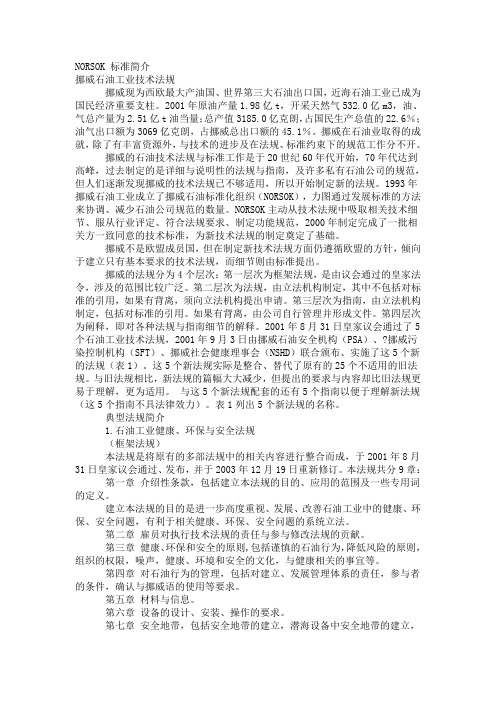
NORSOK 标准简介挪威石油工业技术法规挪威现为西欧最大产油国、世界第三大石油出口国,近海石油工业已成为国民经济重要支柱。
2001年原油产量1.98亿t,开采天然气532.0亿m3,油、气总产量为2.51亿t油当量;总产值3185.0亿克朗,占国民生产总值的22.6%;油气出口额为3069亿克朗,占挪威总出口额的45.1%。
挪威在石油业取得的成就,除了有丰富资源外,与技术的进步及在法规、标准约束下的规范工作分不开。
挪威的石油技术法规与标准工作是于20世纪60年代开始,70年代达到高峰,过去制定的是详细与说明性的法规与指南,及许多私有石油公司的规范,但人们逐渐发现挪威的技术法规已不够适用,所以开始制定新的法规。
1993年挪威石油工业成立了挪威石油标准化组织(NORSOK),力图通过发展标准的方法来协调、减少石油公司规范的数量。
NORSOK主动从技术法规中吸取相关技术细节、服从行业评定、符合法规要求、制定功能规范,2000年制定完成了一批相关方一致同意的技术标准,为新技术法规的制定奠定了基础。
挪威不是欧盟成员国,但在制定新技术法规方面仍遵循欧盟的方针,倾向于建立只有基本要求的技术法规,而细节则由标准提出。
挪威的法规分为4个层次:第一层次为框架法规,是由议会通过的皇家法令,涉及的范围比较广泛。
第二层次为法规,由立法机构制定,其中不包括对标准的引用,如果有背离,须向立法机构提出申请。
第三层次为指南,由立法机构制定,包括对标准的引用。
如果有背离,由公司自行管理并形成文件。
第四层次为阐释,即对各种法规与指南细节的解释。
2001年8月31日皇家议会通过了5个石油工业技术法规,2001年9月3日由挪威石油安全机构(PSA)、?挪威污染控制机构(SFT)、挪威社会健康理事会(NSHD)联合颁布、实施了这5个新的法规(表1)。
这5个新法规实际是整合、替代了原有的25个不适用的旧法规。
与旧法规相比,新法规的篇幅大大减少,但提出的要求与内容却比旧法规更易于理解,更为适用。
NORSOK_L-005 (译文)
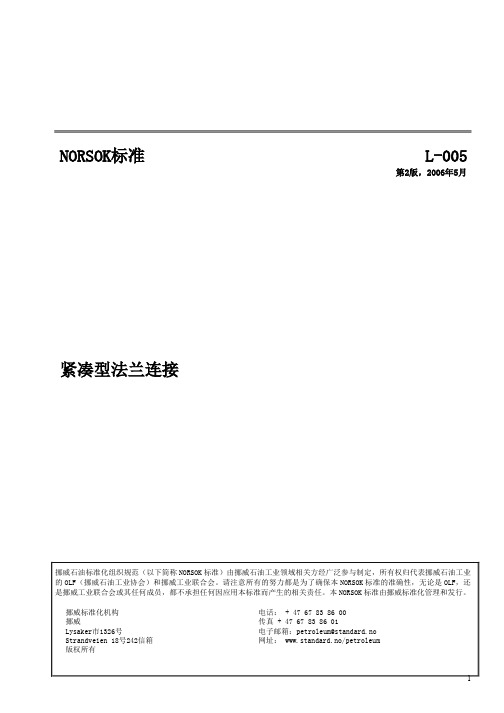
NORSOK标准L-005第2版,2006年5月紧凑型法兰连接挪威石油标准化组织规范(以下简称NORSOK标准)由挪威石油工业领域相关方经广泛参与制定,所有权归代表挪威石油工业的OLF(挪威石油工业协会)和挪威工业联合会。
请注意所有的努力都是为了确保本NORSOK标准的准确性,无论是OLF,还是挪威工业联合会或其任何成员,都不承担任何因应用本标准而产生的相关责任。
本NORSOK标准由挪威标准化管理和发行。
挪威标准化机构电话:+4767838600挪威传真+4767838601Lysaker市1326号电子邮箱:petroleum@standard.noStrandveien18号242信箱网址:www.standard.no/petroleum版权所有前言2简介21范围4 2参考标准和资料42.1参考标准42.2参考资料4 3术语、定义和缩略语53.1定义53.2缩略语64基本设计要求64.1概述64.2材料74.3强度74.4抗腐蚀性84.5温度84.6泄漏84.7供应商特定CFC的信息要求84.8型号和标记85产品标准95.1概述95.2第5条中所采用的参考标准95.3法兰设计和特征的总体说明105.4标准组件115.5型号135.6一般要求135.7尺寸145.8法兰重量145.9法兰表面155.10表面加工155.11容差165.12标记165.13IX型密封圈165.14搬运、安装及组装18附录A(规范性)法兰尺寸和重量27附录B(规范性)密封件尺寸和重量59附录C(规范性)螺栓尺寸和重量64附录D(规范性)压力温度等级70附录E(资料性)材料72附录F(资料性)公制螺栓74附录G(资料性)规定事项说明76附录H(规范性)整体法兰角的选择77参考文献86前言本NORSOK标准由挪威石油工业制定,以确保挪威石油工业的发展和运行足够安全、增值(附加价值)和资金的有效使用。
此外,本标准尽可能在更广的范围内代替石油公司的技术规范,并作为官方规章之用。
EN549中文版
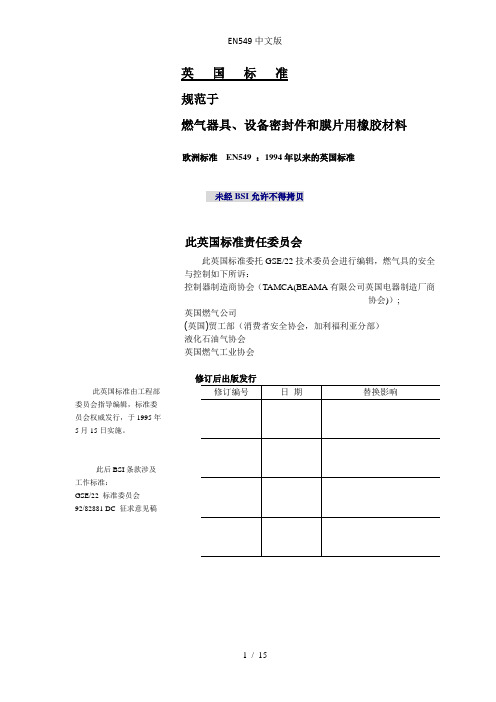
英国标准规范于燃气器具、设备密封件和膜片用橡胶材料欧洲标准EN549 :1994年以来的英国标准未经BSI允许不得拷贝此英国标准责任委员会此英国标准委托GSE/22技术委员会进行编辑,燃气具的安全与控制如下所诉:控制器制造商协会(TAMCA(BEAMA有限公司英国电器制造厂商协会));英国燃气公司(英国)贸工部(消费者安全协会,加利福利亚分部)液化石油气协会英国燃气工业协会修订后出版发行委员会指导编辑,标准委员会权威发行,于1995年5月15日实施。
此后BSI条款涉及工作标准:GSE/22 标准委员会92/82881 DC 征求意见稿前言此英国标准委托GSE/22技术委员会进行编辑,EN 549:1994为英文版,燃气器具、设备密封件和膜片用橡胶材料,由欧洲标准化委员会(CEN)出版。
此标准替代BS 6505。
EN549是由英国积极参加国际讨论后所出版。
互相参照出版物对应英国标准BS(英国国家标准)903 橡胶物性测试ISO48 A26. 硬度确定ISO188 A19. 耐热性与加速老化试验ISO247 BS 7164 原材料与硫化橡胶的化学测试5. 灰分含量的确定方法BS 903 橡胶物性ISO471 A35. 试验片的测试时间、温度、湿度的调节ISO815 A6. 压缩变形的环境、高低温的确定方法ISO1400 A26. 硬度确定ISO1407 BS 1673 橡胶原材料及未加硫复合橡胶的测试方法2.橡胶原材料的化学分析BS 903 橡胶物性测试ISO1431-1 A43. 抗臭氧开裂性确定方法(静态应变测试)ISO1817:1985 A16.1987 液体中效果确定BS 903 橡胶物性测试ISO4648 A38. 用于测试的试验片及产品的尺寸确定方法ISO4650 BS 4181 橡胶红外光谱鉴定1.碳化氢、氯丁二烯、丁腈及氯磺化聚乙烯橡胶的确定方法遵守英国标准,本身并不赋予法律义务的豁免权。
L-002
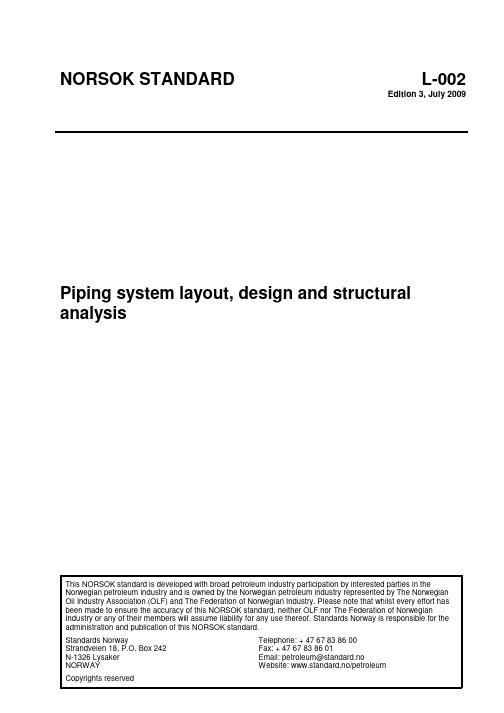
4 5 5 5 5 6 6 6 6 6 7 7 11 11 11 12 12 13 13 14 15 16 20 22 23 23 23 25 25 25 25 25 26 26 26 26 26 27 27 27 28 28 28 28 29 29 31 34
Annex A (Informative) Acoustic fatigue in piping systems Annex B (Informative) Acoustic resonance with flexible riser as initiating source
NORSOK standard L-002
Edition 3, July 2009
Foreword 1 2 2.1 2.2 3 3.1 3.2 4 4.1 4.2 4.3 4.4 5 5.1 5.2 5.3 5.4 5.5 5.6 5.7 5.8 5.9 5.10 5.11 5.12 5.13 5.14 6 6.1 6.2 6.3 6.4 6.5 6.6 6.7 6.8 6.9 6.10 6.11 6.12 6.13 6.14 6.15 6.16 6.17 Scope Normative and informative references Normative references Informative references Terms, definitions and abbreviations Terms and definitions Abbreviations Layout General Miscellaneous requirements Material handling requirements Safety and work environment Piping design General Numbering systems Arrangement Clearance and accessibility Provisions for easy maintenance, testing and cleaning operations Valves Vents, drains and sample connections Equipment piping Additional requirements related to piping systems Fittings Hook-up piping Hoses and flexible pipes Instrumentation Welding Structural analysis of piping systems General Analysis Selection criteria Calculation models Design temperature Environmental temperature Pressures Explosion loads Fire, heat and noise insulation Vessel/deck deflections Vessel accelerations Dynamic loads Other loads Fatigue Loads from piping systems on equipment Flanges Pipe supports
国际主要石油组织对油船检查标准要求

世界主要石油组织对油船检查要求介绍世界主要石油组织对油船检查要求介绍目录编写说明第1部分综述——石油组织对油船检查的特性1、目的2、定义与缩写3、石油组织对油船检查的目的4、石油组织对油船检查的机构5、石油组织对油船检查的特点6、石油组织对油船检查的程序7、对石油组织检查缺陷的分析8、石油组织对有关公约规定的具体要求9、石油组织对油船的附加要求第2部分港口国控制对油船的检查1、澳大利亚港口国控制对油船的检查2、英国港口国控制对油船的检查3、美国港口国控制对油船的检查第3部分世界主要石油组织对油船的检查1、石油公司国际海事论坛(OCIMF)2、独立油船船东国际协会(INTERTANKO)3、欧洲化学品分类协会(CDI)4、船舶检查调查表(VIQ)(中英)5、船舶检查调查表(VIQ)应用说明6、船舶概况调查表(VPQ)(中英)7、船舶概况调查表(VPQ)应用说明第4部分世界主要石油公司对油船的检查1、意大利AGIP System2、美国加利福尼亚州(California)ARCO Marine Service3、美国加利福尼亚州(California)Chevron (谢夫隆)Shipp ing Company LLC4、美国俄克拉何马州(Oklahoma)CITGO Petroleum Corpo ration5、美国得克萨斯州(Texas)TEXACO(得斯古)Oil Trading and Transport, MaritimeInspection and Consulting Service6、法国TOTALFINA7、法国SOMARELF8、英国BP Amoco Group Ship Vetting Service9、英国CONOCO INC.10、英国Exxon Mobile Corporation(埃克森-莫比尔)11、英国SHELL International Trading and Shipping Co. Limited(STASCO)(英国壳牌)12、澳大利亚BHP Transport & Logistics Limited13、新加坡CALTEX Marine Service14、日本IDEMITSU Ship Vetting Service15、委内瑞拉Petroleos de Venezuela S.A.(PDVSA)16、马来西亚PETRONAS Maritime Services Sdn Bhd17、西班牙REPSOL Vetting Services (RVS)18、挪威Statoil/Norsk Hydro ASA/Philips Petroleum Co. (U K)/Preem PetroleumAB19、沙特阿拉伯VELA International Marine Ltd第1部分综述——石油组织对油船检查的特性1、目的世界主要石油组织和石油公司,对其租船、停靠其码头、载运其货物、以及载运与其利益相关的货物时,均要对第三方的油船、化学品船及液化气船进行检查。
石油行业的行业标准与规范了解石油行业的标准和合规要求

石油行业的行业标准与规范了解石油行业的标准和合规要求石油行业的行业标准与规范: 了解石油行业的标准和合规要求石油行业作为全球能源行业的重要组成部分,扮演着至关重要的角色。
为了保证石油行业的可持续发展和安全运营,各国纷纷制定了一系列的行业标准与规范。
本文将介绍石油行业的标准与合规要求。
一、石油行业标准的概述石油行业标准旨在规范石油行业的生产、加工、储存、运输等关键环节,确保石油资源的高效利用和环境的可持续保护。
这些标准通常由石油行业协会、国家石油管理机构或者国际标准化组织制定。
石油行业标准的种类繁多,包括但不限于以下几个方面:1.1. 石油勘探与开发标准石油勘探与开发标准主要涉及石油资源储量评估方法、勘探技术、钻井与完井工艺、油藏改造与提高采收率等方面。
这些标准旨在确保勘探与开发过程的科学性、高效性和资源的合理开采。
1.2. 石油生产加工标准石油生产加工标准涵盖了从油井开采到炼油等生产流程中的各个环节。
这些标准包括油井工程标准、油气分离与处理标准、储运输标准、炼油及石油化工标准等。
通过遵循这些标准,石油企业可以实现高效生产、优质产品和安全运营。
1.3. 石油环境保护标准石油行业对环境的影响较大,因此环境保护标准显得尤为重要。
这些标准涵盖了石油勘探、开发、生产、加工等各个环节对环境的影响评估和控制要求。
例如,应对油污染、二氧化碳排放、废水处理等问题制定的相应标准都属于石油环境保护标准的范畴。
二、石油行业合规要求的重要性石油行业合规是指企业在开展业务活动时遵守相关法律法规、行业标准和公司内部规章制度的要求。
合规要求的重要性不言而喻,它直接影响着企业的经营效益、社会声誉,以及员工和公众的生命财产安全。
以下是石油行业常见的合规要求:2.1. 安全生产合规作为高风险行业,石油行业的安全生产合规至关重要。
企业必须遵守国家和地方各级政府相关的安全生产法律法规,建立健全安全风险评估、预防和应急措施,确保高风险环节的安全运营。
ISO标准简介.讲义

ISO简介:国际标准化组织(International Organization for Standardization)简称ISO,是一个全球性的非政府组织,是国际标准化领域中一个十分重要的组织。
ISO的任务是促进全球范围内的标准化及其有关活动,以利于国际间产品与服务的交流,以及在知识、科学、技术和经济活动中发展国际间的相互合作。
它显示了强大的生命力,吸引了越来越多的国家参与其活动。
ISO的由来国际标准化活动最早开始于电子领域,于1906年成立了世界上最早的国际标准化机构---国际电工委员会(IEC)。
其他技术领域的工作原先有成立于1926年的国家标准化协会的国际联盟(International Federation of the National Standardizing Associations,简称ISA)承担,重点在于机械工程方面。
ISA的工作在1942年终止。
1946年,来自25个国家的代表在伦敦召开会议,决定成立一个新的国际组织,其目的是促进国际间的合作和行业标准的统一。
于是,ISO这一新组织于1947年2月23日正式成立,总部设在瑞士的日内瓦。
ISO于1951年发布了第一个标准---工业长度测量用标准参考温度。
许多人注意到国际标准化组织(International Organization for Standardization)的全名与缩写之间存在差异,为什么不是“IOS”呢?其实,“ISO”并不是首字母缩写,而是一个词,它来源于希腊语,意为“相等”,现在有一系列用它作前缀的词,诸如“isometric”(意为“尺寸相等”)“isonomy”(意为“法律平等”)。
从“相等”到“标准”,内涵上的联系使“ISO”成为组织的名称。
ISO的组织结构其组织机构包括全体大会、主要官员、成员团体、通信成员、捐助成员、政策发展委员会、理事会、ISO中央秘书处、特别咨询组、技术管理处、标样委员会、技术咨询组、技术委员会等。
挪威船级社规范(DNV)2005
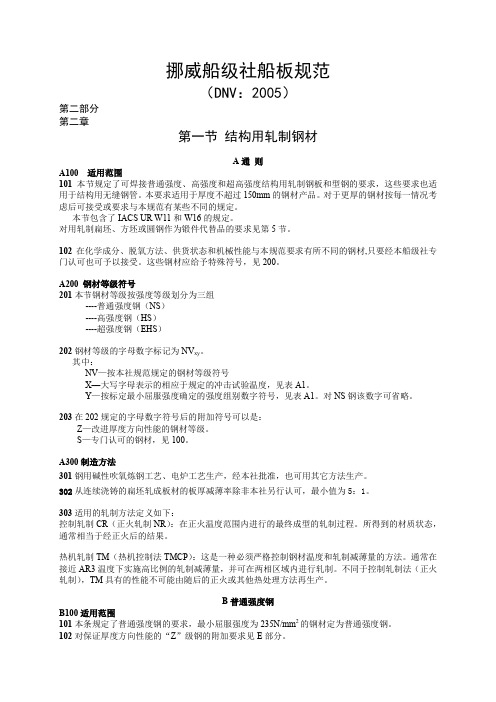
挪威船级社船板规范(DNV:2005)第二部分第二章第一节结构用轧制钢材A通则A100 适用范围101本节规定了可焊接普通强度、高强度和超高强度结构用轧制钢板和型钢的要求,这些要求也适用于结构用无缝钢管。
本要求适用于厚度不超过150mm的钢材产品。
对于更厚的钢材按每一情况考虑后可接受或要求与本规范有某些不同的规定。
本节包含了IACS UR W11和W16的规定。
对用轧制扁坯、方坯或圆钢作为锻件代替品的要求见第5节。
102在化学成分、脱氧方法、供货状态和机械性能与本规范要求有所不同的钢材,只要经本船级社专门认可也可予以接受。
这些钢材应给予特殊符号,见200。
A200 钢材等级符号201本节钢材等级按强度等级划分为三组----普通强度钢(NS)----高强度钢(HS)----超强度钢(EHS)202钢材等级的字母数字标记为NV xy。
其中:NV—按本社规范规定的钢材等级符号X—大写字母表示的相应于规定的冲击试验温度,见表A1。
Y—按标定最小屈服强度确定的强度组别数字符号,见表A1。
对NS钢该数字可省略。
203在202规定的字母数字符号后的附加符号可以是:Z—改进厚度方向性能的钢材等级。
S—专门认可的钢材,见100。
A300制造方法301钢用碱性吹氧炼钢工艺、电炉工艺生产,经本社批准,也可用其它方法生产。
302从连续浇铸的扁坯轧成板材的板厚减薄率除非本社另行认可,最小值为5:1。
303适用的轧制方法定义如下:控制轧制CR(正火轧制NR):在正火温度范围内进行的最终成型的轧制过程。
所得到的材质状态,通常相当于经正火后的结果。
热机轧制TM(热机控制法TMCP):这是一种必须严格控制钢材温度和轧制减薄量的方法。
通常在接近AR3温度下实施高比例的轧制减薄量,并可在两相区域内进行轧制。
不同于控制轧制法(正火轧制),TM具有的性能不可能由随后的正火或其他热处理方法再生产。
B普通强度钢B100适用范围101本条规定了普通强度钢的要求,最小屈服强度为235N/mm2的钢材定为普通强度钢。
02 NORSOK M501 Edition 6-2012 表面处理和防护涂层 C

前言-----------------------------------------------------------------------------------------------------4 介绍-----------------------------------------------------------------------------------------------------4 1.范围------------------------------------------------------------------------------------------------5 2.标准和信息参考---------------------------------------------------------------------------------5
Standard Norway Strandveien 18, P.O.Box 242 N-1326 Lysaker 挪威 保留版权
电话:+47 67 83 86 00 传真:+47 67 83 86 01 E-mail: petroleum@standard.no www.standard.no/petroleum
NORSOK STANDARD
M-501
第 6 版, 2012 年 2 月
NORSOK M-501
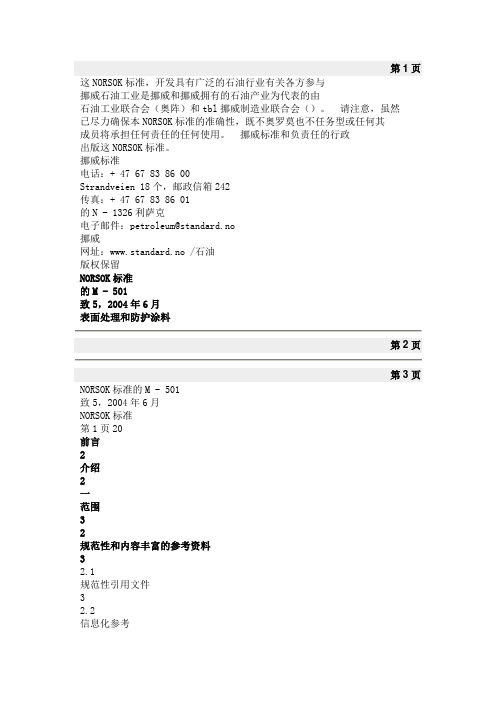
这NORSOK标准,开发具有广泛的石油行业有关各方参与挪威石油工业是挪威和挪威拥有的石油产业为代表的由石油工业联合会(奥阵)和tbl挪威制造业联合会()。
请注意,虽然已尽力确保本NORSOK标准的准确性,既不奥罗莫也不任务型或任何其成员将承担任何责任的任何使用。
挪威标准和负责任的行政出版这NORSOK标准。
挪威标准电话:+ 47 67 83 86 00Strandveien 18个,邮政信箱242传真:+ 47 67 83 86 01的N - 1326利萨克电子邮件:*********************挪威网址:www.standard.no /石油版权保留NORSOK标准的M - 501致5,2004年6月表面处理和防护涂料NORSOK标准的M - 501致5,2004年6月NORSOK标准第1页20前言2介绍2一范围32规范性和内容丰富的参考资料32.1规范性引用文件32.2信息化参考43术语,定义和缩略语43.1术语和定义43.2缩略语54一般要求54.1一般54.2规划54.3设备的保护和清理54.4环境条件54.5涂层材料54.6钢材64.7车间底漆64.8没有油漆的表面64.9处理和产品的运输涂层64.10资格预审的产品,人员和程序 74.11金属涂层74.12记录和报告75健康,安全和环境76表面处理76.1预爆破准备工作 76.2喷射清洗76.3最后的表面状况 87涂料的应用87.1一般87.2应用设备87.3应用88热喷涂金属涂层98.1一般98.2涂层材料98.3热喷涂涂层的应用 98.4维修,现场填写管道钢涂料和涂层中, 99喷洒被动防火99.1一般99.2物料99.3应用109.4维修1010资格要求1010.1资格预审的产品1010.2资格的公司和人员1210.3资格的程序1311检验和测试14附录A(规范性)涂料系统15附件B(信息)颜色20NORSOK标准的M - 501致5,2004年6月NORSOK标准第2页20前言制定标准的NORSOK由挪威石油工业,以确保足够的安全,增值和成本效益为石油工业的发展和运营。
DNV挪威船级社规范2003版 中文 4.3柴油机1
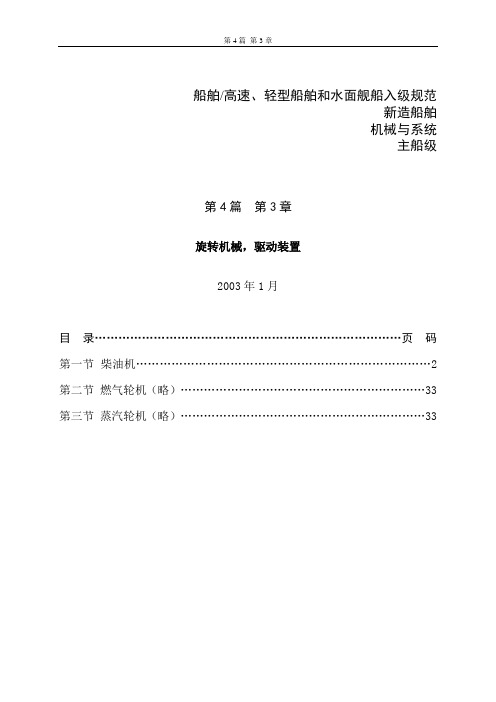
第4篇第3章船舶/高速、轻型船舶和水面舰船入级规范新造船舶机械与系统主船级第4篇第3章旋转机械,驱动装置2003年1月目录..............................................................................页码第一节柴油机 (2)第二节燃气轮机(略) (33)第三节蒸汽轮机(略) (33)船舶入级规范2003-目录目录第一节. 柴油机 (2)A. 通则 (2)B. 设计 (8)C. 检查和试验 (16)D.车间试验.........................................18E 控制、报警、安全功能和指示. (20)F.布置 (24)G.振动 (25)H.安装检查 (30)I.船上试验 (31)第一节柴油机A. 通则A 100 适用范围101本节包含的要求适用于需要认证的柴油机、汽油机、燃气和混合燃料发动机,见第2章第1节,也适用于柴油机的安装和船上试验。
但是,对于功率小于200KW的柴油机,本节要求仅限于:—高压油管的套式冷却和含易燃液体的管路中管接头的接地,见B700和B1100—发热表面的隔热,见B1100— B1507中规定的型式试验的要求— D107中规定的车间试验的要求—应急发电机的监测要求(如适用),见E700。
以原油或气为运行介质的装置,附加的要求见本规范第6篇第13章。
102规范B到E适用于柴油机、它的部件及内部系统。
规范F到I适用于发动机的安装、发动机及其系统动力(系统动力受发动机的影响)、和船上试验。
103柴油机的应有NV证书,NV证书以B设计认可、C试验和检验和D车间试验中的适用要求为依据。
额定功率小于200kw的柴油机,NV证书仅以B 设计认可和D车间试验中的适用要求为依据,见101。
在第2章第2节A102的情况下,NV证书的要求可予免除。
104表1表示了柴油机的认证过程,其中生产商是一个许可证持有人或拥有设计资格的制造者。
DNV规范——挪威船级社

RP-F10X RP-F108 RP-F201 RP-F202
RP-F10X
Slide 2
2002-01-25
DNV Pipeline Committee Meeting January 2002
Will be issued bi-annually (October/March) Will give an overview of all DNV Offshore Codes with
– – – – Date of issue Date of Amendments and corrections Is downloadable and printable from internet FOC Will not be printed
4: "Pipeline Systems"
Initial purchase price: NOK 2000, update service fee: NOK 1000
5: "DNV Offshore Standards"
Initial purchase price: NOK 7000, update service fee: NOK 2000
DNV Offshore Codes -
CD package; Pipeline Systems (April -02)
Offshore Service Specifications
DNV-OSS-301 Certification and Verification of Pipelines
DNV挪威船级社规范2003版 中文 1.1总则3
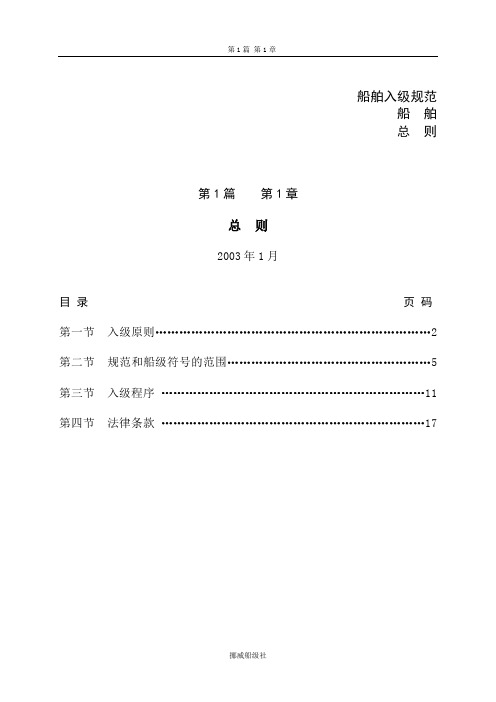
第1篇第1章船舶入级规范船舶总则第1篇第1章总则2003年1月目录页码第一节入级原则 (2)第二节规范和船级符号的范围 (5)第三节入级程序 (11)第四节法律条款 (17)船舶入级规范-目录目录第一节入级原则 (2)A.定义 (2)A 100 一般要求 (2)A 200 规范 (2)A 300 审核 (2)B.入级概念 (2)B 100 一般要求 (2)B 200 规范的生效和实施 (2)B 300 授予船级的依据 (3)B 400 保留船级的依据 (3)B 500 文件的提供 (3)B 600 信息的公开 (3)B 700 本社责任的限度 (4)B 800 垂直的合同审核和国家海事主管机关的审核 (4)第二节规范和船级符号的范围 (5)A.规范的范围 (5)A 100 一般要求 (5)A 200 规范的应用 (5)A 300 规范的要点 (5)B.船级符号 (5)B 100 一般要求 (5)B 200 建造符号 (5)B 300 船级主字符 (5)B 400 航区船级符号 (5)B 500 其他的航行限制 (5)B 600 附加船级:服务和类型船级符号 (5)B 700 附加船级:设备和系统船级符号 (8)B 800 附加船级:特征船级符号 (9)B 900 国家规则 (9)B 1000 附加船级:NAUTICUS (9)第三节入级程序 (11)A.船级的授予 (11)A 100 入级申请 (11)A 200 对车间和船厂的要求 (11)A 300 对制造厂的要求...........................11 A 400 对提供服务者的要求 (11)A 500 对设备校准的要求 (11)A 600 图纸认可 (11)A 700 检验 (11)A 800 功能试验 (12)A 900 材料、部件和系统的证书 (12)A 1000 制造检验安排 (13)A 1100 船型认可 (13)A 1200 国家主管机关检验的接受 (13)A 1300 临时船级证书 (13)A 1400入级证书 (13)A 1500 入级证书附录 (13)A 1600 以DNV分级的船舶录的记入 (14)A 1700 入级申请的降低 (14)B.船级的保留 (14)B 100 一般要求 (14)B 200 定期检验和换证检验 (14)B 300 破损检验 (14)B 400 修理检验 (14)B 500 保留程序 (14)B 600 改建和改装 (14)B 700 产权的变更 (15)B 800 船级条件和备忘录 (15)B 900 检验报告和检验状态 (15)B 1000 新造船舶规范适用于营运中船舶 (15)C.船级的中止和取消 (16)C 100 一般要求 (16)C 200 船级的中止 (16)C 300 船级的取消 (16)C 400 重新入级 (16)D.申诉 (16)D 100 本社所作的决定 (16)第四节法律条款 (17)A.责任和权限 (17)A 100 有限责任 (17)A 200 管辖法律 (17)A 300 审判地点 (17)第一节入级原则A.定义A 100 一般要求101 本规范所采用一般术语的定义,见第0篇第2章第1节A200。
tema c标准

tema c标准全文共四篇示例,供读者参考第一篇示例:Tema C标准是一种用于油气工业设备设计与制造的标准规范,其主要目的是为了保证设备在正常运行及高压、高温等极端工况下的安全可靠性。
该标准由挪威石油协会(Norwegian Petroleum Directorate)与挪威斯塔万格斯石油公司(Statoil)联合开发,逐渐成为国际上广泛应用的标准之一。
Tema C标准包括了许多方面的规范,主要涉及到设备设计、材料选用、制造工艺、安装与维护等方面的内容。
设备设计是Tema C标准的核心之一,它要求设备设计应满足所需的强度、刚度、密封性等要求,并考虑到设备在操作过程中可能受到的各种外力影响。
Tema C标准还要求设备在设计中应考虑到对环境的适应性,比如耐腐蚀、耐高温等特性。
在材料选择方面,Tema C标准要求使用高质量的材料,如碳钢、不锈钢、镍基合金等,以确保设备在长期使用中不发生腐蚀、疲劳等问题。
Tema C标准还规定了材料的质量控制要求,包括材料的化学成分、机械性能、表面处理等方面。
在制造工艺方面,Tema C标准要求制造过程中应严格遵守相关工艺规范,确保设备的工艺性能与设计要求相符。
制造过程中应进行严格的质量控制,包括原材料检验、工艺过程检验、最终产品检验等环节,以保证设备的质量。
在安装与维护方面,Tema C标准也提出了具体的要求。
设备的安装应按照设计要求进行,安装过程中要注意设备的密封性、支撑性等问题,确保设备在正常运行中不会出现问题。
设备的维护也应按照相关规范进行,定期检查设备的运行情况,及时发现并处理可能存在的问题,确保设备的长期稳定运行。
Tema C标准是一种为油气工业设备设计与制造提供指导的标准规范,它通过严格的要求和规定,保障了设备的安全可靠性。
在实际应用中,企业应充分理解Tema C标准的内容,严格遵守相关规定,确保设备的设计、制造、安装与维护都符合标准要求,最大程度地提高设备的可靠性和安全性。
- 1、下载文档前请自行甄别文档内容的完整性,平台不提供额外的编辑、内容补充、找答案等附加服务。
- 2、"仅部分预览"的文档,不可在线预览部分如存在完整性等问题,可反馈申请退款(可完整预览的文档不适用该条件!)。
- 3、如文档侵犯您的权益,请联系客服反馈,我们会尽快为您处理(人工客服工作时间:9:00-18:30)。
NORSOK标准——挪威石油标准化组织规范
共22个压缩包。
NORSOK 标准简介
挪威石油工业技术法规
挪威现为西欧最大产油国、世界第三大石油出口国,近海石油工业已成为国民经济重要支柱。
2001年原油产量1.98亿t,开采天然气532.0亿m3,油、气总产量为2.51亿t油当量;总产值3185.0亿克朗,占国民生产总值的22.6%;油气出口额为3069亿克朗,占挪威总出口额的45.1%。
挪威在石油业取得的成就,除了有丰富资源外,与技术的进步及在法规、标准约束下的规范工作分不开。
挪威的石油技术法规与标准工作是于20世纪60年代开始,70年代达到高峰,过去制定的是详细与说明性的法规与指南,及许多私有石油公司的规范,但人们逐渐发现挪威的技术法规已不够适用,所以开始制定新的法规。
1993年挪威石油工业成立了挪威石油标准化组织(NORSOK),力图通过发展标准的方法来协调、减少石油公司规范的数量。
NORSOK主动从技术法规中吸取相关技术细节、服从行业评定、符合法规要求、制定功能规范,2000年制定完成了一批相关方一致同意的技术标准,为新技术法规的制定奠定了基础。
挪威不是欧盟成员国,但在制定新技术法规方面仍遵循欧盟的方针,倾向于建立只有基本要求的技术法规,而细节则由标准提出。
三维网技术论坛.
挪威的法规分为4个层次:第一层次为框架法规,是由议会通过的皇家法令,涉及的范围比较广泛。
第二层次为法规,由立法机构制定,其中不包括对标准的引用,如果有背离,须向立法机构提出申请。
第三层次为指南,由立法机构制定,包括对标准的引用。
如果有背离,由公司自行管理并形成文件。
第四层次为阐释,即对各种法规与指南细节的解释。
2001年8月31日皇家议会通过了5个石油工业技术法规,2001年9月3日由挪威石油安全机构(PSA)、?挪威污染控制机构(SFT)、挪威社会健康理事会(NSHD)联合颁布、实施了这5个新的法规(表1)。
这5个新法规实际是整合、替代了原有的25个不适用的旧法规。
与旧法规相比,新法规的篇幅大大减少,但提出的要求与内容却比旧法规更易于理解,更为适用。
与这5个新法规配套的还有5个指南以便于理解新法规(这5个指南不具法律效力)。
表1列出5个新法规的名称。
典型法规简介
1.石油工业健康、环保与安全法规
(框架法规)
本法规是将原有的多部法规中的相关内容进行整合而成,于2001年8月31日皇家议会通过、发布,并于2003年12月19日重新修订。
本法规共分9章:
第一章介绍性条款,包括建立本法规的目的、应用的范围及一些专用词的定义。
建立本法规的目的是进一步高度重视、发展、改善石油工业中的健康、环保、安全问题,有利于相关健康、环保、安全问题的系统立法。
第二章雇员对执行技术法规的责任与参与修改法规的贡献。
第三章健康、环保和安全的原则,包括谨慎的石油行为,降低风险的原则,组织的权限,噪声,健康、环境和安全的文化,与健康相关的事宜等。
第四章对石油行为的管理,包括对建立、发展管理体系的责任,参与者的条件,确认与挪威语的使用等要求。
第五章材料与信息。
第六章设备的设计、安装、操作的要求。
第七章安全地带,包括安全地带的建立,潜海设备中安全地带的建立,在事故中特殊安全地带的建立,对安全地带的监测、撤出,安全地带的记号、公告等等。
第八章依工作环境而定的特殊规定,如多个雇主在同一区域工作时的原则,安全员停止危险工作的权力,对工作时间、加班、休息的规定等等。
第九章结束性条款,包括权威性的监督,行政管理与保密责任,观察员,立法,个人决定,免除,国家公务员的培训,请求,批准,法规的实施与废止等。
该法规作为框架法规将健康、安全与环保的主导思想贯穿到整个技术法规体系中。
2.石油工业管理法规
该法规由挪威石油安全机构(PSA)、挪威污染控制机构(SFT)挪威社会健康理事会(NSHD)于2002年1月1日联合发布。
2005年1月1日重新修改更新。
该法规包括6章:第一章风险管理,其中有2节,分别为:风险减低、障碍。
第二章管理因素,其中有6节,分别为:健康、安全和环境的管理,目标和策略,内部要求,主要事故风险和环境风险的验收标准,监视参数和指示物,决策的基础和标准。
第三章资源和过程,其中有4节,分别为:计划、工作程序、人员和能力、信息。
第四章分析,其中有5节,分别为:分析的一般要求、主要事故风险的分析、数量风险分析和紧急事件准备分析、环境导向风险和紧急事件准备风险、工作环境分析。
第五章测量,其中有6节,分别为:遵守和开发,数据的采集处理和使用,危险和事故情况的登记,检查和调查,未符合的处理、遵守、开发。
第六章实施,该法规突出了风险管理,使管理目标明确。
3.石油相关的装备设计和配置法规
该法规于2001年9月3日由挪威石油安全机构(PSA)、挪威污染控制机构(SFT)、挪威社会健康理事会(NSHD)联合发布。
该法规包括6章:
第一章入门条款,包括定义、作业船的水下人工操作系统和其他设备。
第二章一般条款,包括开发内容的选择、设备设计、安全功能。
第三章多学科条款,包括:
(1)一般要求:资格、新技术新方法的应用、工厂、系统和设备、负载效果和阻抗、材料、材料处理和运输线路、进入和离开线路、通风和室内气候、化学品和化学品暴露、易燃和爆炸品、监视和录音设备的使用、内外部通讯系统、通讯设备等
(2)工作区域和住宿空间设计:通讯设备人类工程学设计、人机交互界面和信息传递、户外工作区域、噪音和声学、震动、照明、辐射、人员运输设备、安全标识等;
(3)物理屏障: 被动防火、防火分界线、生活区的防火分界线、火与气探测系统、紧急关停系统、过程安全系统、气体释放系统、防火供水系统、固定防火系统、紧急供能和紧急照明、稳定系统、户外排水系统等;
(4)紧急情况预防: 人员急救设备、防止突发污染的材料、备用船只、疏散方法、救生衣、人工灭火和消防人员装备等;
(5)电力装置等。
第四章特别补充条款,包括:
(1)钻井系统:井内挡板、井控设备、补偿器和断开系统、钻井液系统、注水泥单元、下套管和油井固定、完井和井控装备、采油树、管线和钻柱的遥控操作;
(2)采油厂;
(3)主要承载结构和管线系统:主要承载系统、管线系统;
(4)生活区:健康部门、紧急事件单位、食物和饮用水的供应;
(5)海洋设施:稳定、锚定、停泊和定位、塔楼;
(6)潜水系统:手工水下作业的系统和设备;三维,cad,机械,技术,汽
(7)其它附属条款:设备的加载和卸载、废弃物、排气管道、提升设备、直升机甲板、设备的标记、设备和货物的标记、起重机。
第五章实施电子工程协会的法律,包括简单压力容器、个人防护设备、气雾剂、电磁兼容性、 EMC、压力设备、机床和安全成分。
第六章实施,该法规涉及的内容较广泛,突出了作业安全,使作业人员有法可依。
4.石油工业材料与信息法规
该法规规定了石油工业活动的材料和信息的规范:包括了对材料信息的准备、获得、保存期的要求;规定了需上报的材料信息的要求,如钻井信息与井下信息,监控、释放污染风险的信息,要发往其它机构的信息等;规定了警告、通知、报告等,如给监督机构的通知、造成人员伤亡的通知、可能职业病通知、工作时间的报告、手工水下作业的通知、钻井行为的通知、承载结构和管线系统的损伤的报告等。
这一法规使信息、材料的获得与升级都非常规范。
技术法规与技术标准的关系
在《石油工业设备的设计、装配法规》中引用了大量的公认标准,如:22个IEC(国际电工协会)标准、26个ISO(国际标准化组织)标准、6个NS(挪威国家标准)标准、39个NORSOK(挪威石油标准化组织)标准、2个NORDTEST(北欧技术试验协作机构)标准、2个API(美国石油学会)标准、6个EN(欧洲标准)、15个DNV(挪威船级社)标准等等。
由上可见,在挪威石油工业中技术法规与技术标准的关系极为密切。
小结
通过以上分析,发现挪威石油工业技术法规有以下特点:
(1)挪威石油工业技术法规类别清楚、精炼,有提纲携领的感觉;
(2)挪威石油工业技术法规与技术标准结合紧密;
(3) 挪威石油工业技术法规非常注意健康、安全、环保(HSE)工作,将这一法规作为第一层次的技术法规,对其它法规起到统领作用,在其它法规中贯穿着HSE的思想。
一共包括如下标准:。
